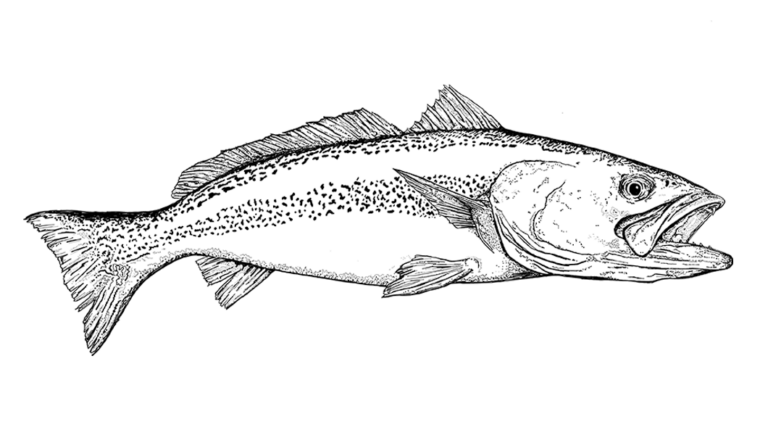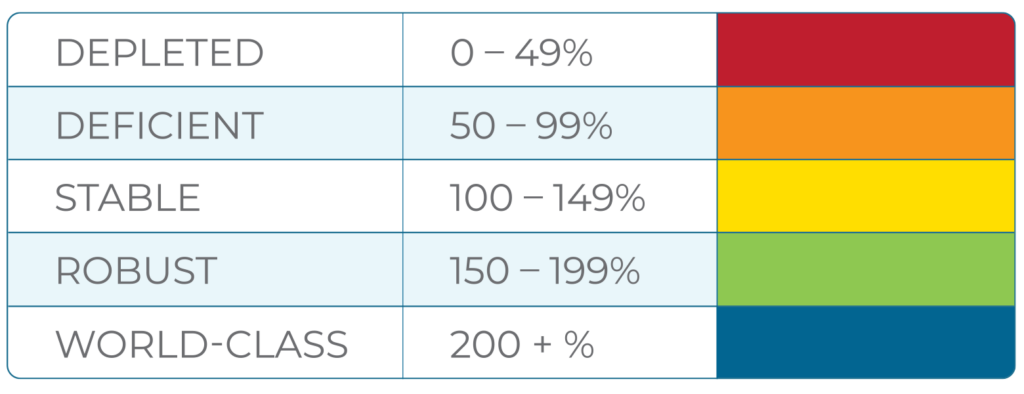Weakfish


22.13% = DEPLETED
How It’s Calculated
FINDEX is a novel way to gauge whether the status of a fish population is trending up or down. Management of most fish species in North Carolina is guided by stock assessment models developed by various groups of scientists. The calculations in our FINDEX metric measure the gap between the desired condition of a fish stock (the Target reference value) and the existing condition (the most recent data year in the model called the Terminal value) as determined in each stock assessment. The gaps between Target and Terminal values are reported as ratios.
For example, if the Target and Terminal values are the same, there would be no gap, and the ratio would be 1.0. The multiplier on our FINDEX barometer would set the FINDEX value at 100% in this example and assign a stock status designation of “Stable.” Categories on the FINDEX barometer are measurable as they track the extent of the gap either above or below the “Stable” designation.
For Weakfish, the gap assessment compared Target and Terminal values of Total Mortality (fishing mortality + natural mortality) and Spawning Stock Biomass from the Atlantic States Marine Fisheries Commission’s most recent stock assessment model. The Terminal year in the model was 2017.
Here's the FINDEX formula used for Weakfish:

- (0.710 x 0.312) x 100 = 22.13
- FINDEX = 22.13% for 2017
- 22.13% = DEPLETED

What Does Depleted Mean?
“Depleted” indicates that the stock is severely impaired. Weakfish are being removed too rapidly from the stock, and the estimated number of spawning females in the population is well below threshold levels for a sustainable fishery. Factors contributing to a Depleted FINDEX status include overfishing, low numbers of mature females, and poor recruitment. High rates of natural mortality have also been observed for Weakfish with predation and competition offered as potential sources.
FINDEX Stock Status Over Time
The stock assessment model for Weakfish provides point estimates of Total Mortality and Spawning Stock Biomass for each year covered in the data set. We’ve compared the Target reference values to these annual point estimates and calculated the ratios (gaps) for each data year from 1982–2017.
Applying the FINDEX gap assessment to the entire time series provides the following stock status trendline:
No Data Found
How Do We Get To World-Class?
FINDEX can also be used to determine when a population has reached “World-Class” status. Because FINDEX factors performance of both Total Mortality and Spawning Stock Biomass into the metric, multiple combinations of these values could potentially lead to a World-Class designation.
Weakfish Target values for Total Mortality (1.03) and Spawning Stock Biomass (6,170 metric tons) have been established by the management agencies. The existing estimates (2017 values) are 1.45 and 1,922 metric tons. Under one potential scenario, if Total Mortality was to drop to the Target value, and Spawning Stock Biomass was to increase to 12,500 metric tons, then the FINDEX value would exceed 200% on our barometer.
Note that during the model years 1994–1999, the Weakfish stock exceeded World-Class status, reaching a FINDEX value of over 400% in 1997. Weakfish Spawning Stock Biomass was estimated at over 19,000 metric tons that year, while the Total Mortality was one of the lowest values observed in the time series (0.73). The vision of the NC Marine & Estuary Foundation is to see our coastal stocks exceed Target expectations as we pursue World-Class fisheries and thriving coastal economies.
Commercial Trends
The graph below illustrates commercial trends for Weakfish from 1990 through 2022. In 2022, commercial fishers harvested 62,196 pounds of Weakfish valued at $86,210. Supporting data was sourced from the North Carolina Department of Environmental Quality.
No Data Found
Recreational Trends
The graph below illustrates recreational trends for Weakfish from 1990 through 2022. In 2022, recreational fishers harvested an estimated 112,095 Weakfish weighing 105,060 pounds. Supporting data was sourced from the North Carolina Department of Environmental Quality.
No Data Found
State Record
- North Carolina’s state record Weakfish was landed at Nags Head in 1980 by Sterling Ammons.
- The record-breaking fish weighed 14 pounds, 14 ounces.
Did you know?
- Weakfish are considered 90% mature at age 1, although older females spawn more frequently and carry more eggs.
- The maximum age recorded for a Weakfish was 17 years for a fish from Delaware Bay.
- Weakfish spawning in North Carolina occurs in sounds and estuaries and peaks from April to June.
Harvest Seasons for Weakfish
- The recreational limit for Weakfish is one fish per day with a 12-inch minimum size limit.
- Commercial harvest seasons for Weakfish can be found here.
What’s Next?
As our team diligently refines FINDEX, we are committed to delivering the most recent stock status updates for North Carolina’s diverse finfish species. Subscribe below to receive a stream of inshore insights and stay current with our coastal initiatives.

